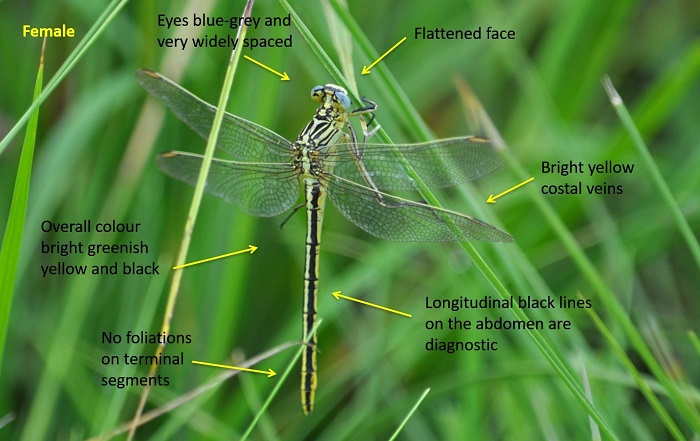View the above photo record (by Alan Manson) in OdonataMAP here.
Find the Southern Yellowjack in the FBIS database (Freshwater Biodiversity Information System) here.
Family Gomphidae
Notogomphus praetorius – SOUTHERN YELLOWJACK
Identification
Medium-large size
Length up to 52mm; Wingspan reaches 70mm.
Notogomphus praetorius is distinctive and not easily confused with other species in South Africa. In terms of colouration it most resembles Ceratogomphus pictus (Common Thorntail), however, the Southern Yellowjack has more vivid yellow colouration and is unique among South African Gomphids in having a pair of longitudinal black lines down the length of the abdomen.
The sexes are rather similar but females are more robustly built.
Click here for more details on identification of the Southern Yellowjack.

Giants Castle, KwaZulu-Natal
Photo by Alan Manson

Umzimkulu Wilderness area, KwaZulu-Natal
Photo by Ryan Tippett
Habitat
Inhabits rivers and streams in mountainous areas, mostly higher than 1000 m above sea level. Occasionally found at well wooded sites, but generally prefers open streams in grassland. Notogomphus praetorius likes clean, clear, flowing water with rocks and an abundance of tall grasses. Very occasionally found at dams.

Photo by Ryan Tippett
Behaviour
Commonly found perched on tall grass stems or bushes along the riverbank. Hangs vertically when perched or sits lengthwise parallel to a drooping stem. Frequently rests on rocks close to the water or in the midstream. Notogomphus praetorius is a weak flier and spends much time perched. Flushes easily from the long grass but soon resettles. Somewhat reminiscent of a grasshopper in flight. Both sexes occur in the same areas.
Status and Conservation
The Yellowjack is locally common and listed as of Least Concern in the IUCN Red List of Threatened Species. It is intolerant of habitat degradation and occurs only in pristine, untouched habitats.
Distribution
Notogomphus praetorius has a disjunct distribution. It is mostly confined to the eastern parts Southern Africa, ranging from Malawi, Zambia and the adjoining DRC, down to eastern Zimbabwe and the escarpment areas of South Africa.
Below is a map showing the distribution of records for Yellowjack in the OdonataMAP database as at February 2020.

The next map below is an imputed map, produced by an interpolation algorithm, which attempts to generate a full distribution map from the partial information in the map above. This map will be improved by the submission of records to the OdonataMAP section of the Virtual Museum.


Ultimately, we will produce a series of maps for all the odonata species in the region. The current algorithm is a new algorithm. The objective is mainly to produce “smoothed” maps that could go into a field guide for odonata. This basic version of the algorithm (as mapped above) does not make use of “explanatory variables” (e.g. altitude, terrain roughness, presence of freshwater — we will be producing maps that take these variables into account soon). Currently, it only makes use of the OdonataMAP records for the species being mapped, as well as all the other records of all other species. The basic maps are “optimistic” and will generally show ranges to be larger than what they probably are.
These maps use the data in the OdonataMAP section of the Virtual Museum, and also the database assembled by the previous JRS funded project, which was led by Professor Michael Samways and Dr KD Dijkstra.



